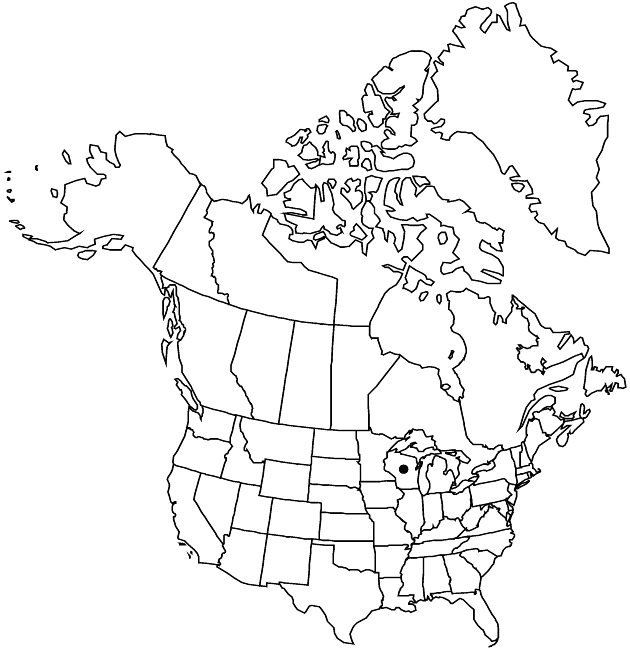Difference between revisions of "Pseudognaphalium saxicola"
Sida 21: 777. 2004.
FNA>Volume Importer |
imported>Volume Importer |
||
| (6 intermediate revisions by 2 users not shown) | |||
| Line 8: | Line 8: | ||
}} | }} | ||
|common_names=Cliff cudweed | |common_names=Cliff cudweed | ||
| − | |basionyms={{Treatment/ID/ | + | |special_status={{Treatment/ID/Special_status |
| + | |code=E | ||
| + | |label=Endemic | ||
| + | }} | ||
| + | |basionyms={{Treatment/ID/Basionym | ||
|name=Gnaphalium saxicola | |name=Gnaphalium saxicola | ||
|authority=Fassett | |authority=Fassett | ||
| + | |rank=species | ||
| + | |publication_title=Rhodora | ||
| + | |publication_place=33: 75. 1931 | ||
}} | }} | ||
|synonyms={{Treatment/ID/Synonym | |synonyms={{Treatment/ID/Synonym | ||
|name=Gnaphalium obtusifolium var. saxicola | |name=Gnaphalium obtusifolium var. saxicola | ||
|authority=(Fassett) Cronquist | |authority=(Fassett) Cronquist | ||
| − | }}{{Treatment/ID/Synonym | + | |rank=variety |
| + | }} {{Treatment/ID/Synonym | ||
|name=Pseudognaphalium obtusifolium var. saxicola | |name=Pseudognaphalium obtusifolium var. saxicola | ||
|authority=(Fassett) Kartesz | |authority=(Fassett) Kartesz | ||
| + | |rank=variety | ||
}} | }} | ||
|hierarchy=Asteraceae;Asteraceae tribe Gnaphalieae;Pseudognaphalium;Pseudognaphalium saxicola | |hierarchy=Asteraceae;Asteraceae tribe Gnaphalieae;Pseudognaphalium;Pseudognaphalium saxicola | ||
| Line 33: | Line 42: | ||
|elevation=200–300 m | |elevation=200–300 m | ||
|distribution=Wis. | |distribution=Wis. | ||
| − | |discussion=<p>Pseudognaphalium saxicola probably is an evolutionary derivative of P. obtusifolium. Plants of P. saxicola are relatively small and have relatively few, relatively small heads and occur in a specialized habitat; they constitute the only narrowly endemic species of Pseudognaphalium in the United States. Depauperate individuals of P. obtusifolium from localities over its whole geographic range may sometimes be as short as 5–10 cm and similar in habit to P. saxicola; such plants differ from P. saxicola in their close and denser stem vestiture, bicolor and relatively narrow leaves, larger heads with greater numbers of pistillate florets, and broader phyllaries with rounded apices.</p> | + | |discussion=<p><i>Pseudognaphalium saxicola</i> probably is an evolutionary derivative of <i>P. obtusifolium</i>. Plants of <i>P. saxicola</i> are relatively small and have relatively few, relatively small heads and occur in a specialized habitat; they constitute the only narrowly endemic species of <i>Pseudognaphalium</i> in the United States. Depauperate individuals of <i>P. obtusifolium</i> from localities over its whole geographic range may sometimes be as short as 5–10 cm and similar in habit to <i>P. saxicola</i>; such plants differ from <i>P. saxicola</i> in their close and denser stem vestiture, bicolor and relatively narrow leaves, larger heads with greater numbers of pistillate florets, and broader phyllaries with rounded apices.</p> |
|tables= | |tables= | ||
|references= | |references= | ||
| Line 42: | Line 51: | ||
-->{{#Taxon: | -->{{#Taxon: | ||
name=Pseudognaphalium saxicola | name=Pseudognaphalium saxicola | ||
| − | |||
|authority=(Fassett) H. E. Ballard & Feller | |authority=(Fassett) H. E. Ballard & Feller | ||
|rank=species | |rank=species | ||
| Line 56: | Line 64: | ||
|publication title=Sida | |publication title=Sida | ||
|publication year=2004 | |publication year=2004 | ||
| − | |special status= | + | |special status=Endemic |
| − | |source xml=https:// | + | |source xml=https://bitbucket.org/aafc-mbb/fna-data-curation/src/2e0870ddd59836b60bcf96646a41e87ea5a5943a/coarse_grained_fna_xml/V19-20-21/V19_687.xml |
|tribe=Asteraceae tribe Gnaphalieae | |tribe=Asteraceae tribe Gnaphalieae | ||
|genus=Pseudognaphalium | |genus=Pseudognaphalium | ||
Latest revision as of 19:54, 5 November 2020
Annuals, 4–15(–30) cm; taprooted. Stems (filiform) persistently tomentose (indument a loose, envelope-like, transparent haze of extremely thin hairs, doubling apparent stem width), not glandular. Leaf blades elliptic-oblanceolate to oblanceolate, 0.5–3 cm × 2–6 mm (largest at midstem), bases not clasping, not decurrent, margins flat, faces concolor, green, thinly arachnoid-tomentose to glabrate, not glandular (veiny reticulum evident). Heads (2–4) in terminal, capitate clusters (usually immediately subtended by distalmost cauline leaf, clusters sometimes in subcorymbiform arrays). Involucres turbinate, 4–5 mm. Phyllaries in 3(–4) series, whitish to slightly tawny (hyaline, shiny), narrowly triangular to narrowly oblong-triangular, glabrous. Pistillate florets 25–28. Bisexual florets 6–7. Cypselae not ridged, smooth.
Phenology: Flowering (Jul–)Aug–Sep.
Habitat: Mostly bare sandstone cliff faces, ledges, and cracks, s- to e-facing, commonly shaded
Elevation: 200–300 m
Discussion
Pseudognaphalium saxicola probably is an evolutionary derivative of P. obtusifolium. Plants of P. saxicola are relatively small and have relatively few, relatively small heads and occur in a specialized habitat; they constitute the only narrowly endemic species of Pseudognaphalium in the United States. Depauperate individuals of P. obtusifolium from localities over its whole geographic range may sometimes be as short as 5–10 cm and similar in habit to P. saxicola; such plants differ from P. saxicola in their close and denser stem vestiture, bicolor and relatively narrow leaves, larger heads with greater numbers of pistillate florets, and broader phyllaries with rounded apices.
Selected References
None.
